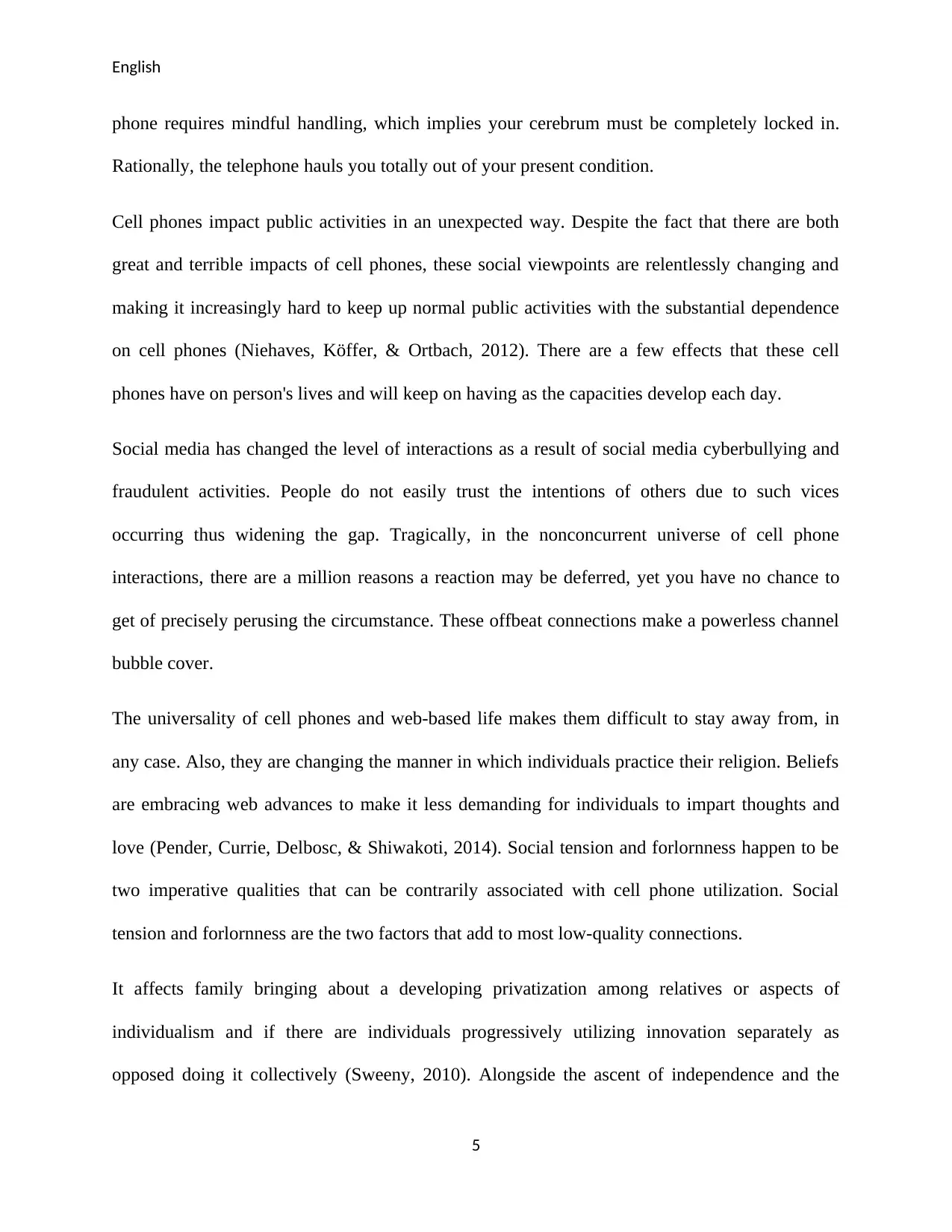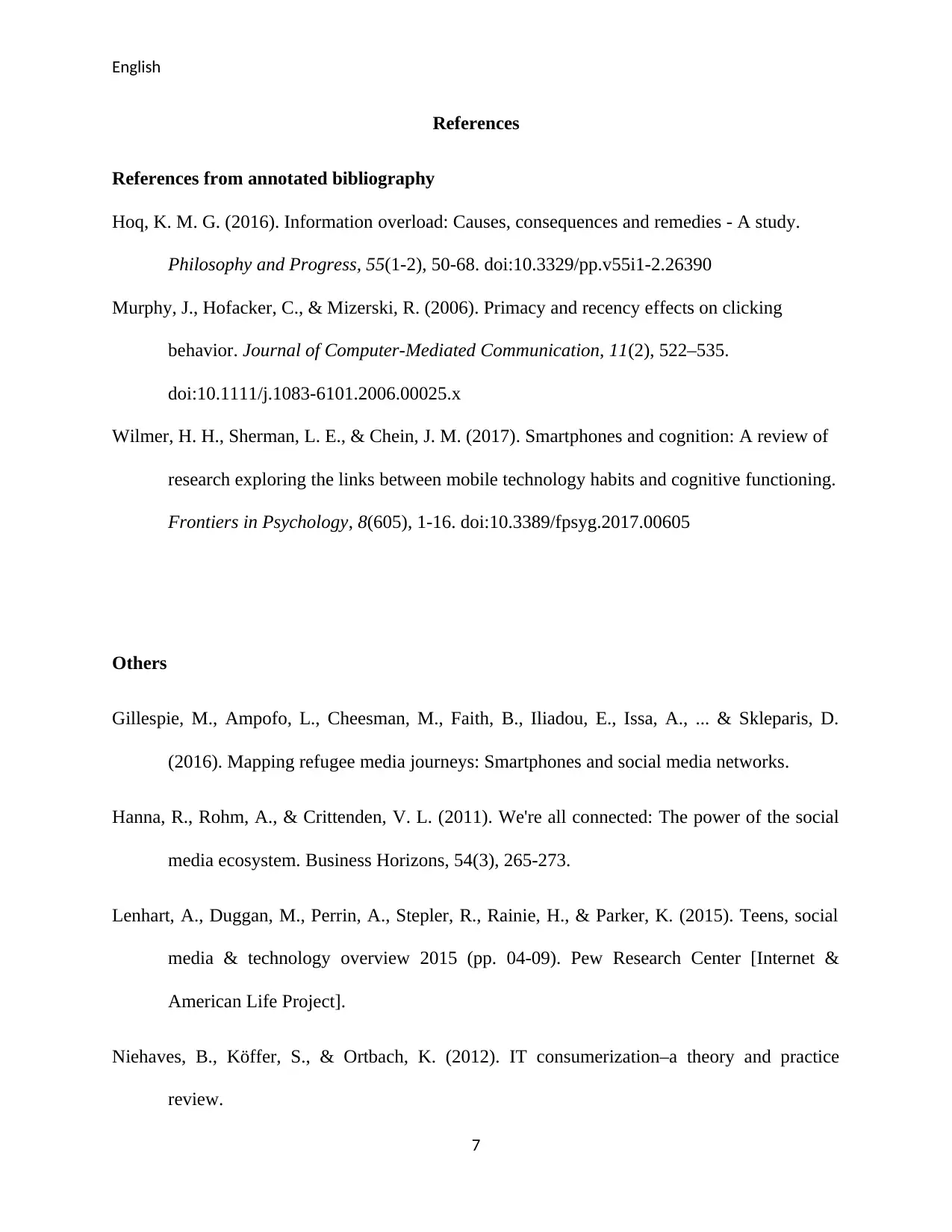Annotated Bibliography: Instant Access to Information - ENGL1201
VerifiedAdded on 2023/05/28
|8
|1954
|196
Report
AI Summary
This annotated bibliography examines the multifaceted impact of instant access to information in the modern world. The report delves into the perils and possibilities associated with the rapid dissemination of data through various technological platforms, including social media and smartphones. The bibliography comprises several sources, including peer-reviewed articles, exploring the effects of instant information on communication, education, business, and societal structures. The sources address topics such as information overload, the rise of fake news, the impact on cognitive functions, and the changing dynamics of social interactions. The report also includes an analysis of how technology is affecting individuals' lives. The bibliography is comprehensive, providing insights into the benefits and drawbacks of instant access to information and highlighting the need for critical evaluation and responsible usage in an increasingly digital world.

English
English
Name
Institution
Professor
Course
Date
1
English
Name
Institution
Professor
Course
Date
1
Paraphrase This Document
Need a fresh take? Get an instant paraphrase of this document with our AI Paraphraser

English
The perils and possibilities of instant access to information
It is evident that technological advancement has contributed to the improvement of everybody
lives in various unpredictable ways. It has literary changed the manner in which people
communicate, interact and does wok activities. Information advancement has led to instant
access to information across the world. Instant access to information contributes to greater
opportunities and merits (Hoq,2016). It is possible to acquire immediate information through
email notifications, Facebook, Twitter and Google which has become widely used by people. It
has been vastly acknowledging diversification of education systems, offices, family interaction
and in business for example shopping online.
It has increased its access to a large number of people across the world. Instant access to
information has made the world a "global village" (Murphy, Hofacker & Mizerski,2006). It
assists the world to move at a faster rate, efficiently in terms of business such as currency
exchange thus positively impacting the economy
According to Hoq (2016) messaging tools has increased interaction between people across the
world thus interchange of culture between societies. It has also led to the improvement of
internet connection since it increased entertainment.
Like most domains there exist the downside part to the increased abundance and fastness of a
particular technology. Various smartphones and social media platforms enable individuals to
acquire ideas and information over a very short period of time. This immediate access to
information comes with several perils. Information technology is slowly creating an addiction to
instant gratification. The information gadget that is easy to carry can provide people with
immediate access to entertainment, communication medium and also the whole knowledge base
2
The perils and possibilities of instant access to information
It is evident that technological advancement has contributed to the improvement of everybody
lives in various unpredictable ways. It has literary changed the manner in which people
communicate, interact and does wok activities. Information advancement has led to instant
access to information across the world. Instant access to information contributes to greater
opportunities and merits (Hoq,2016). It is possible to acquire immediate information through
email notifications, Facebook, Twitter and Google which has become widely used by people. It
has been vastly acknowledging diversification of education systems, offices, family interaction
and in business for example shopping online.
It has increased its access to a large number of people across the world. Instant access to
information has made the world a "global village" (Murphy, Hofacker & Mizerski,2006). It
assists the world to move at a faster rate, efficiently in terms of business such as currency
exchange thus positively impacting the economy
According to Hoq (2016) messaging tools has increased interaction between people across the
world thus interchange of culture between societies. It has also led to the improvement of
internet connection since it increased entertainment.
Like most domains there exist the downside part to the increased abundance and fastness of a
particular technology. Various smartphones and social media platforms enable individuals to
acquire ideas and information over a very short period of time. This immediate access to
information comes with several perils. Information technology is slowly creating an addiction to
instant gratification. The information gadget that is easy to carry can provide people with
immediate access to entertainment, communication medium and also the whole knowledge base
2

English
of an existing website (Wilmer,Sherman, & Chein, 2017).). It is evident that not everything is
supposed to be near instant. For example, acquiring information fast enhances people to order for
products online. However, individuals still have to wait for a given period of time in order to get
their product purchases delivered to their premises. Some online shopping platforms thus claim
that they can deliver goods for less than two hours across the world which leads to fraudulent
activities. People are also mostly concerned with finishing jobs, tasks and several assignments in
a quick manner rather than being concerned with the quality.
Instant access to information is causing some uncalled for perils. Clearly, some things require
more time to accomplish. Finishing a particular website in a couple of hours makes it lower its
quality and strength (Gillespie et al, 2016). There is a vital reason which it should take longer in
order to complete. Instant access to information has thus contributed to individuals rushing to
make uninformed decisions hence ending up messing up and reducing the quality of achieving
important things. They no longer pay attention to details.
Immediate access to information has led to the high spread of fake news across the world
through social media platforms such as Facebook and Twitter
Instant access to information is affecting the society since it has led to the development of a
certain culture of impatience and forgetfulness since people are getting used to it. For example in
TV waiting several months for a whole series season is deemed as too long, hence the need for
Netflix in order to access the show immediately.
Instant access to information, as part of the education system like online classes, lowers the
education system (Hanna, Rohm & Crittenden, 2011). This aspect is quite detrimental to learning
since answer materials are always within reach hence contributes to cheating in exams and thus
3
of an existing website (Wilmer,Sherman, & Chein, 2017).). It is evident that not everything is
supposed to be near instant. For example, acquiring information fast enhances people to order for
products online. However, individuals still have to wait for a given period of time in order to get
their product purchases delivered to their premises. Some online shopping platforms thus claim
that they can deliver goods for less than two hours across the world which leads to fraudulent
activities. People are also mostly concerned with finishing jobs, tasks and several assignments in
a quick manner rather than being concerned with the quality.
Instant access to information is causing some uncalled for perils. Clearly, some things require
more time to accomplish. Finishing a particular website in a couple of hours makes it lower its
quality and strength (Gillespie et al, 2016). There is a vital reason which it should take longer in
order to complete. Instant access to information has thus contributed to individuals rushing to
make uninformed decisions hence ending up messing up and reducing the quality of achieving
important things. They no longer pay attention to details.
Immediate access to information has led to the high spread of fake news across the world
through social media platforms such as Facebook and Twitter
Instant access to information is affecting the society since it has led to the development of a
certain culture of impatience and forgetfulness since people are getting used to it. For example in
TV waiting several months for a whole series season is deemed as too long, hence the need for
Netflix in order to access the show immediately.
Instant access to information, as part of the education system like online classes, lowers the
education system (Hanna, Rohm & Crittenden, 2011). This aspect is quite detrimental to learning
since answer materials are always within reach hence contributes to cheating in exams and thus
3
⊘ This is a preview!⊘
Do you want full access?
Subscribe today to unlock all pages.

Trusted by 1+ million students worldwide

English
lower the quality of education. This is potentially a dangerous stuff for education system since
knowledge is immediately available at Google search.
It also leads to an overload of information since every information comes at such an instant pace.
It creates laziness and time wastage. People have high expectation and addiction to immediate
results leading to a lot of failures and nervousness. Instant access to information is also slowly
ruining the manner in which people interact, communicate and interact. It is slowly taking away
actual experiences. It has affected personal information since if one does not get instant feedback
or response it increases the probability of one getting angry.
Smartphones and social media
Smartphones and social media involve a leading platform worldwide that enhances the sharing of
ideologies and various insight between people thus affecting the business today, subcultural
activities and the entire society. The smartphone has been a means of communication from one
place to another. The smartphone and social media has increased the quality of communication
strategies hence moving it unprecedented points.
It has also increased marketing strategies as companies use social media to advertise its products
to target audience reaching a wide network of clientele base. It has also increased online
socialization making people become active members of society.
Today, one of these surprising issues is rising. The cell phone is driving a central change in the
manner in which we connect as people and it might affect our joy. People are social creatures.
We look for fraternity and acknowledgment (Lenhart et al 2016). The connections we construct
are basic to our individual joy and prosperity. Also, considerably more, to associate with a cell
4
lower the quality of education. This is potentially a dangerous stuff for education system since
knowledge is immediately available at Google search.
It also leads to an overload of information since every information comes at such an instant pace.
It creates laziness and time wastage. People have high expectation and addiction to immediate
results leading to a lot of failures and nervousness. Instant access to information is also slowly
ruining the manner in which people interact, communicate and interact. It is slowly taking away
actual experiences. It has affected personal information since if one does not get instant feedback
or response it increases the probability of one getting angry.
Smartphones and social media
Smartphones and social media involve a leading platform worldwide that enhances the sharing of
ideologies and various insight between people thus affecting the business today, subcultural
activities and the entire society. The smartphone has been a means of communication from one
place to another. The smartphone and social media has increased the quality of communication
strategies hence moving it unprecedented points.
It has also increased marketing strategies as companies use social media to advertise its products
to target audience reaching a wide network of clientele base. It has also increased online
socialization making people become active members of society.
Today, one of these surprising issues is rising. The cell phone is driving a central change in the
manner in which we connect as people and it might affect our joy. People are social creatures.
We look for fraternity and acknowledgment (Lenhart et al 2016). The connections we construct
are basic to our individual joy and prosperity. Also, considerably more, to associate with a cell
4
Paraphrase This Document
Need a fresh take? Get an instant paraphrase of this document with our AI Paraphraser

English
phone requires mindful handling, which implies your cerebrum must be completely locked in.
Rationally, the telephone hauls you totally out of your present condition.
Cell phones impact public activities in an unexpected way. Despite the fact that there are both
great and terrible impacts of cell phones, these social viewpoints are relentlessly changing and
making it increasingly hard to keep up normal public activities with the substantial dependence
on cell phones (Niehaves, Köffer, & Ortbach, 2012). There are a few effects that these cell
phones have on person's lives and will keep on having as the capacities develop each day.
Social media has changed the level of interactions as a result of social media cyberbullying and
fraudulent activities. People do not easily trust the intentions of others due to such vices
occurring thus widening the gap. Tragically, in the nonconcurrent universe of cell phone
interactions, there are a million reasons a reaction may be deferred, yet you have no chance to
get of precisely perusing the circumstance. These offbeat connections make a powerless channel
bubble cover.
The universality of cell phones and web-based life makes them difficult to stay away from, in
any case. Also, they are changing the manner in which individuals practice their religion. Beliefs
are embracing web advances to make it less demanding for individuals to impart thoughts and
love (Pender, Currie, Delbosc, & Shiwakoti, 2014). Social tension and forlornness happen to be
two imperative qualities that can be contrarily associated with cell phone utilization. Social
tension and forlornness are the two factors that add to most low-quality connections.
It affects family bringing about a developing privatization among relatives or aspects of
individualism and if there are individuals progressively utilizing innovation separately as
opposed doing it collectively (Sweeny, 2010). Alongside the ascent of independence and the
5
phone requires mindful handling, which implies your cerebrum must be completely locked in.
Rationally, the telephone hauls you totally out of your present condition.
Cell phones impact public activities in an unexpected way. Despite the fact that there are both
great and terrible impacts of cell phones, these social viewpoints are relentlessly changing and
making it increasingly hard to keep up normal public activities with the substantial dependence
on cell phones (Niehaves, Köffer, & Ortbach, 2012). There are a few effects that these cell
phones have on person's lives and will keep on having as the capacities develop each day.
Social media has changed the level of interactions as a result of social media cyberbullying and
fraudulent activities. People do not easily trust the intentions of others due to such vices
occurring thus widening the gap. Tragically, in the nonconcurrent universe of cell phone
interactions, there are a million reasons a reaction may be deferred, yet you have no chance to
get of precisely perusing the circumstance. These offbeat connections make a powerless channel
bubble cover.
The universality of cell phones and web-based life makes them difficult to stay away from, in
any case. Also, they are changing the manner in which individuals practice their religion. Beliefs
are embracing web advances to make it less demanding for individuals to impart thoughts and
love (Pender, Currie, Delbosc, & Shiwakoti, 2014). Social tension and forlornness happen to be
two imperative qualities that can be contrarily associated with cell phone utilization. Social
tension and forlornness are the two factors that add to most low-quality connections.
It affects family bringing about a developing privatization among relatives or aspects of
individualism and if there are individuals progressively utilizing innovation separately as
opposed doing it collectively (Sweeny, 2010). Alongside the ascent of independence and the
5

English
decrease in family esteems, new media innovations are currently significantly more inundated
into individuals' day by day schedules than any time in recent memory.
Online networking additionally gives a stage to some less exquisite practices and feelings. In
spite of the fact that there are mind-blowing assets, friendships, and data over the web that
upgrade life, there is nothing as remarkable and satisfying when associating face to face without
the screen. As the remarkable technology advancement has spread into each field of our life, we
need to make up for lost time with it to remain socially dynamic members of the network.
Social pressure is said to originate from an over inordinate utilization of cell phones, as well.
Since there are such a significant number of people who use cell phones to impart so much of the
time, certain maladaptive propensities are or can be framed (Turban et al, 2018). However social
media and smartphones has increased the rate at which people interact and share ideas. It has
made people and governments interact harmoniously and in unity. People are able to interact
through online trading. They are also able to help each other in times of calamities no matter
where one comes from.
6
decrease in family esteems, new media innovations are currently significantly more inundated
into individuals' day by day schedules than any time in recent memory.
Online networking additionally gives a stage to some less exquisite practices and feelings. In
spite of the fact that there are mind-blowing assets, friendships, and data over the web that
upgrade life, there is nothing as remarkable and satisfying when associating face to face without
the screen. As the remarkable technology advancement has spread into each field of our life, we
need to make up for lost time with it to remain socially dynamic members of the network.
Social pressure is said to originate from an over inordinate utilization of cell phones, as well.
Since there are such a significant number of people who use cell phones to impart so much of the
time, certain maladaptive propensities are or can be framed (Turban et al, 2018). However social
media and smartphones has increased the rate at which people interact and share ideas. It has
made people and governments interact harmoniously and in unity. People are able to interact
through online trading. They are also able to help each other in times of calamities no matter
where one comes from.
6
⊘ This is a preview!⊘
Do you want full access?
Subscribe today to unlock all pages.

Trusted by 1+ million students worldwide

English
References
References from annotated bibliography
Hoq, K. M. G. (2016). Information overload: Causes, consequences and remedies - A study.
Philosophy and Progress, 55(1-2), 50-68. doi:10.3329/pp.v55i1-2.26390
Murphy, J., Hofacker, C., & Mizerski, R. (2006). Primacy and recency effects on clicking
behavior. Journal of Computer-Mediated Communication, 11(2), 522–535.
doi:10.1111/j.1083-6101.2006.00025.x
Wilmer, H. H., Sherman, L. E., & Chein, J. M. (2017). Smartphones and cognition: A review of
research exploring the links between mobile technology habits and cognitive functioning.
Frontiers in Psychology, 8(605), 1-16. doi:10.3389/fpsyg.2017.00605
Others
Gillespie, M., Ampofo, L., Cheesman, M., Faith, B., Iliadou, E., Issa, A., ... & Skleparis, D.
(2016). Mapping refugee media journeys: Smartphones and social media networks.
Hanna, R., Rohm, A., & Crittenden, V. L. (2011). We're all connected: The power of the social
media ecosystem. Business Horizons, 54(3), 265-273.
Lenhart, A., Duggan, M., Perrin, A., Stepler, R., Rainie, H., & Parker, K. (2015). Teens, social
media & technology overview 2015 (pp. 04-09). Pew Research Center [Internet &
American Life Project].
Niehaves, B., Köffer, S., & Ortbach, K. (2012). IT consumerization–a theory and practice
review.
7
References
References from annotated bibliography
Hoq, K. M. G. (2016). Information overload: Causes, consequences and remedies - A study.
Philosophy and Progress, 55(1-2), 50-68. doi:10.3329/pp.v55i1-2.26390
Murphy, J., Hofacker, C., & Mizerski, R. (2006). Primacy and recency effects on clicking
behavior. Journal of Computer-Mediated Communication, 11(2), 522–535.
doi:10.1111/j.1083-6101.2006.00025.x
Wilmer, H. H., Sherman, L. E., & Chein, J. M. (2017). Smartphones and cognition: A review of
research exploring the links between mobile technology habits and cognitive functioning.
Frontiers in Psychology, 8(605), 1-16. doi:10.3389/fpsyg.2017.00605
Others
Gillespie, M., Ampofo, L., Cheesman, M., Faith, B., Iliadou, E., Issa, A., ... & Skleparis, D.
(2016). Mapping refugee media journeys: Smartphones and social media networks.
Hanna, R., Rohm, A., & Crittenden, V. L. (2011). We're all connected: The power of the social
media ecosystem. Business Horizons, 54(3), 265-273.
Lenhart, A., Duggan, M., Perrin, A., Stepler, R., Rainie, H., & Parker, K. (2015). Teens, social
media & technology overview 2015 (pp. 04-09). Pew Research Center [Internet &
American Life Project].
Niehaves, B., Köffer, S., & Ortbach, K. (2012). IT consumerization–a theory and practice
review.
7
Paraphrase This Document
Need a fresh take? Get an instant paraphrase of this document with our AI Paraphraser

English
Pender, B., Currie, G., Delbosc, A., & Shiwakoti, N. (2014). Social media use during unplanned
transit network disruptions: a review of the literature. Transport Reviews, 34(4), 501-521.
Sweeny, S. M. (2010). Writing for the instant messaging and text messaging generation: Using
new literacies to support writing instruction. Journal of Adolescent & Adult Literacy,
54(2), 121-130.
Turban, E., Outland, J., King, D., Lee, J. K., Liang, T. P., & Turban, D. C. (2017). Electronic
commerce 2018: a managerial and social networks perspective. Springer.
8
Pender, B., Currie, G., Delbosc, A., & Shiwakoti, N. (2014). Social media use during unplanned
transit network disruptions: a review of the literature. Transport Reviews, 34(4), 501-521.
Sweeny, S. M. (2010). Writing for the instant messaging and text messaging generation: Using
new literacies to support writing instruction. Journal of Adolescent & Adult Literacy,
54(2), 121-130.
Turban, E., Outland, J., King, D., Lee, J. K., Liang, T. P., & Turban, D. C. (2017). Electronic
commerce 2018: a managerial and social networks perspective. Springer.
8
1 out of 8
Related Documents
Your All-in-One AI-Powered Toolkit for Academic Success.
+13062052269
info@desklib.com
Available 24*7 on WhatsApp / Email
![[object Object]](/_next/static/media/star-bottom.7253800d.svg)
Unlock your academic potential
Copyright © 2020–2025 A2Z Services. All Rights Reserved. Developed and managed by ZUCOL.





